The 2022 Rieju MR Ranger 200 & 300 are Rieju’s answer for those wanting simple yet good-performing, easy-to-ride two-stroke trail bikes that still look cool and won’t break the bank.
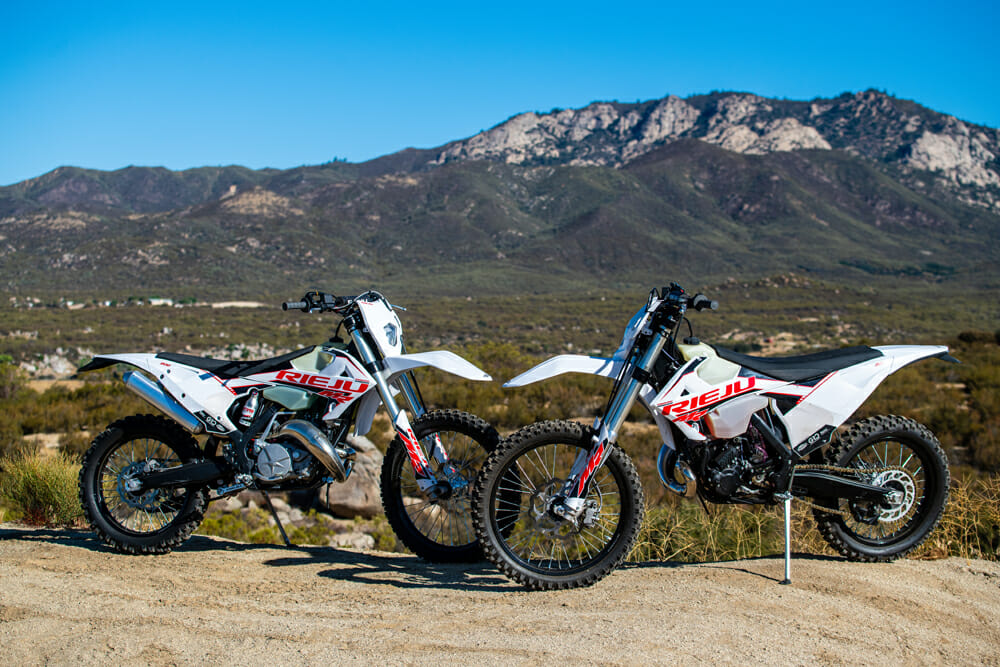
By the CN Staff | Photography by Kit Palmer
We know what you’re thinking—what’s a Rieju? (We pronounce it: Re-yay-who.) Simplified, it’s the original GasGas. When KTM acquired the rights to the GasGas name in 2019, the small Spanish manufacturer Rieju, which started out building bicycles in 1934 and produced its first motorcycle in 1953, stepped in and acquired everything that KTM left behind, including the GasGas factory and all the tooling. Rieju didn’t have far to go since both Rieju and GasGas are based in Spain. In a nutshell, Rieju picked up where the original GasGas platform left off.
Rieju USA imports several Rieju models, all enduro two-strokes in three displacement sizes: 200cc, 250cc and 300cc. (In our opinion, that’s a great start.) Some of these bikes are serious racers, such as the Six Days and MR Pro and MR Racing models, while some are not, like the MR Ranger line. Today, we’re checking out the Rangers.
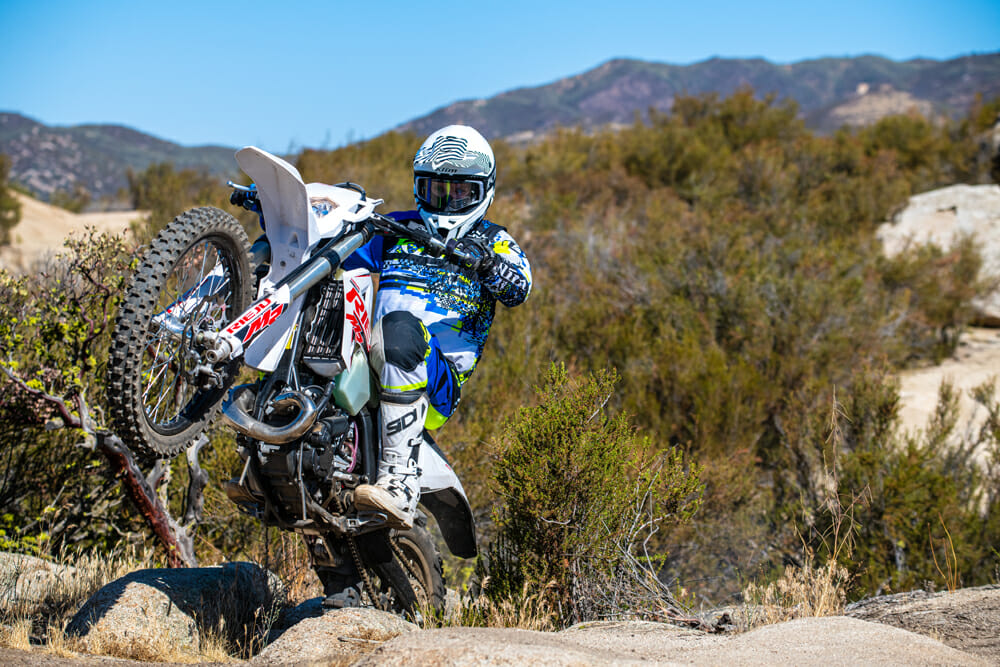
The MR Rangers come in two flavors—200cc and 300cc. The selling points for these motorcycles are their lower seat heights, user-friendly power delivery, and affordability—$8599 for the 200 and $8799 for the 300. And, of course, they are two-strokes.
The Rangers are modeled closely after their premium race-bike brothers. Take a close look and you’ll see they are nearly identical. The Rangers share the same frame, chassis, suspension, and engines as the race bikes, but you don’t get all the bells and whistles that they have. And the Rangers’ engines are tuned considerably different than the high-performance Pro and Racing models. The more mild Rangers are tuned for torque, not speed. Kind of like trials bikes. In Rieju’s words, both Rangers “have had their tuning altered to make them deliver smoother, more user-friendly power.” Simply put, these bikes are marketed for trail riders, young and old, with a wide variety of riding skills who have no interest in going fast and who want lightweight and easy-to-live-with two-strokes.
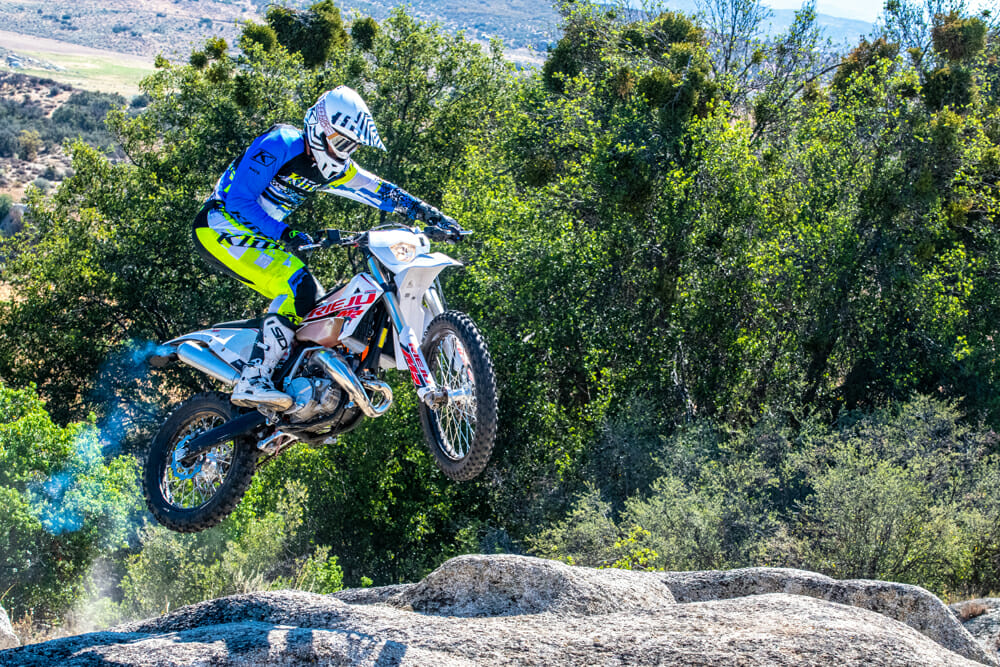
2022 Rieju MR Ranger 200 & 300 | Meat And Potatoes
We’ll get right to what you probably want to know most. Yes, the Rangers are carbureted; both are fitted with 36mm PWK Mikunis. Yes, they both have electric starting systems with a manual kick for backup. No, they are not oil-injected, so you must keep the Ratio-Rite nearby. Yes, they have hydraulically operated clutches. No, they don’t have crankshaft counterbalancers, which seems to be a two-stroke trend these days. And, no, they don’t come fitted with suspension components you never heard of; instead, they come with more familiar KYB units that are fully adjustable.
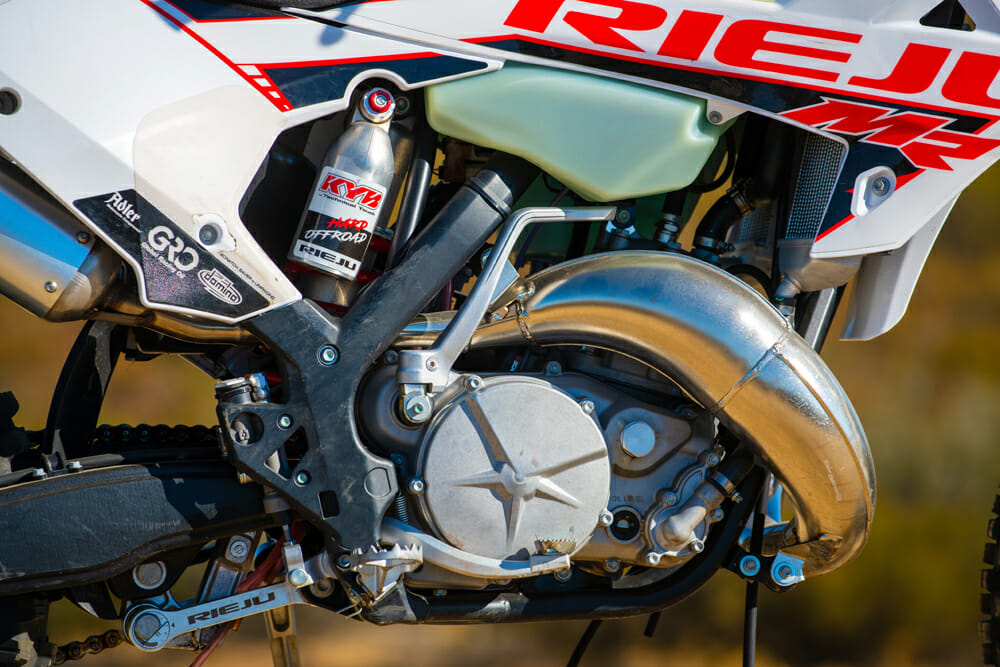
2022 Rieju MR Ranger 200 & 300 | Get On And Hold On
The first thing you will notice when you get on the Rangers is their lower seat height compared to their Racing and Pro siblings. The Ranger’s seat is 1.5 inches closer to the ground than the race bikes, 36.3 versus 37.8 inches. That might not seem like much on paper, but it’s a lot on the seat. The lower seat height was achieved by reducing wheel travel and designing a thinner seat. An adjustable rear shock link can reduce seat height even further.
A seemingly powerful (and loud, we might add) starter motor quickly brings the Rangers to life, and you’re quickly reminded that these bikes are indeed carbureted. They feel overly rich until they reach proper operating temperature but even then, a hint of blue smoke from the exhaust never completely goes away. We ran your standard 40:1 fuel/oil mixture. They do seem to run a bit rich overall, but, oddly, they don’t bog, burble or hesitate like you’d think they would by the way they sound. Instead, the throttle response from both bikes is surprisingly good.

2022 Rieju MR Ranger 200
We’ll focus on the 200cc first. Simply put, Rieju’s description of the 200cc is spot on. It is indeed a “trail bike.” Think of it like that, and you’ll be fine. It’s not a race bike like its MR Racing 200 twin brother, but it is a solid, good-performing and user-friendly trail cruiser that is a ton of fun to ride—as long as—you don’t feel the need to go fast. It’s just not meant to be ridden that way.
Compared to the MR Racing 200, the Ranger 200 comes fitted with a smaller carburetor (36mm versus 38mm) and a super-restrictive exhaust pipe. Just look at that long and skinny header! And the 300’s doesn’t look much bigger. The 200 has been tuned for bottom-to-mid power. After that, it falls flat. It doesn’t sound all that appealing, does it? But give it a try.
If you always seek out tight and technical trails when you ride, you will enjoy the Ranger 200. The Ranger 200 loves to be ridden casually and up and over almost anything in its path, like a trials bike—the more technical the terrain, the more the 200 excels. The bike is impossible to stall and can torque its way up almost anything, way better than most 200s. And the light-pull Magura hydraulic clutch (which you’ll be using a lot) does a great job of helping you manage to get its petite power to the ground. When you combine the 200’s torquey engine with its low seat height and overall light weight (although we feel it should be lighter for a 200), you feel you can conquer anything. Riding the Ranger 200 is a confidence-booster when it comes to technical riding.
The suspension falls right into place. It is also tuned (soft) for slower-speed riding and feels just fine when ridden that way. However, you’ll quickly outride the suspension if you try to go race speeds, but, again, this bike isn’t meant to do that.
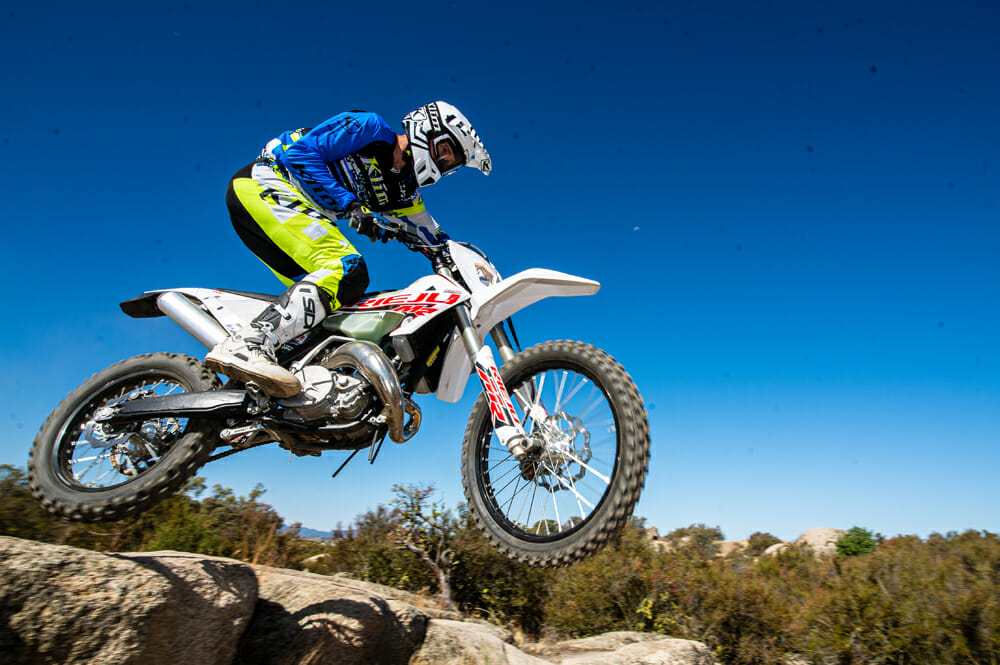
2022 Rieju MR Ranger 300
The Ranger 300 has similar mannerisms as the 200 but has a hint of seriousness about it. Like the 200, it’s also all bottom-to-mid when it comes to power delivery; however, the overall power in that range is nothing to sneeze at. It responds when you open the throttle anytime down low. It likes to go when you do that, but you don’t have to worry about the handlebars ripping out of your hands as you do with some 300cc two-stroke race bikes. But the fun instantly stops from midrange-on-up; like the 200, this is when the 300 suddenly poops out. Still, the 300 is far superior than the 200 on open terrain and climbing hills.
And, like the 200, the 300 runs smoothly and just won’t stall, making it ideal for Tennessee Knockout-type terrain. A great clutch and low seat height help here, as well. We did miss the counterbalancers, though. Since KTM started putting counterbalancers in its bigger-bore two-strokes, as do now Beta and Sherco, we’ve become hypersensitive to two-stroke vibration. It’s not bad with the Rieju, just noticeable.
Again, like the 200, it’s when the trails open and the whoops get bigger that the 300’s weaknesses begin to show. But, again, this isn’t what either Ranger is designed for. Their suspensions are very soft, not great for aggressive riding but welcomed over the rocks and roots at a slower pace.
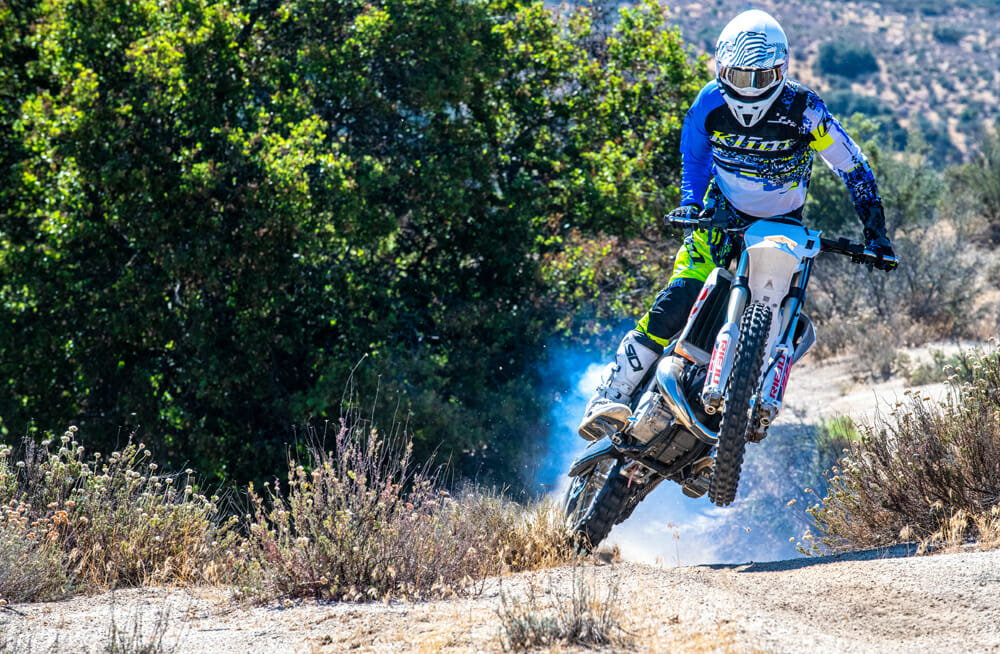
Both bikes are very comfortable, and their seats are simply outstanding. You’ll be doing a lot of sitting on these bikes, so a comfy cushion is a major plus. Also, you don’t slide around on their grippy covers. The bikes feel slim and narrow between your legs, but they also feel heavier than they should for two-strokes. Previous GasGas two-strokes have also struggled with weight.
Speaking of comparable models, the closest rival to the Rangers is Beta’s 300cc XTrainer, which we tested last month. (You can read the 2022 Beta Xtrainer review here. KTM used to offer the 250cc two-stroke Freeride which has since gone electric, so we suppose you could throw the old or new Freeride into the mix if you want. But the bigger Ranger and XTrainer are the most closely matched. Both bikes feature 300c two-stroke liquid-cooled engines, electric starting, and lower seat heights compared to their nearest of kin. Notable differences between the two? The XTrainer is a good 10-plus pounds lighter, is oil-injected, has a slightly lower seat height, and sells for approximately $700 less than the MR 300 Ranger. The Ranger, however, uses higher-quality KYB suspension components versus the XTrainer’s lesser-known Olle components, and the Ranger holds approximately 0.4-gallons more fuel.
The MR 200 Ranger has no real opposition, at least none that we can think of.
Overall, both Rangers are enjoyable motorcycles. They are, like Rieju says, simple, easy-to-ride trail bikes that will accommodate a wide range of riders, even entry-level riders. The 300 is a little more serious than the 200 and could even be raced in a local enduro, depending on the terrain—the gnarlier, the better. CN
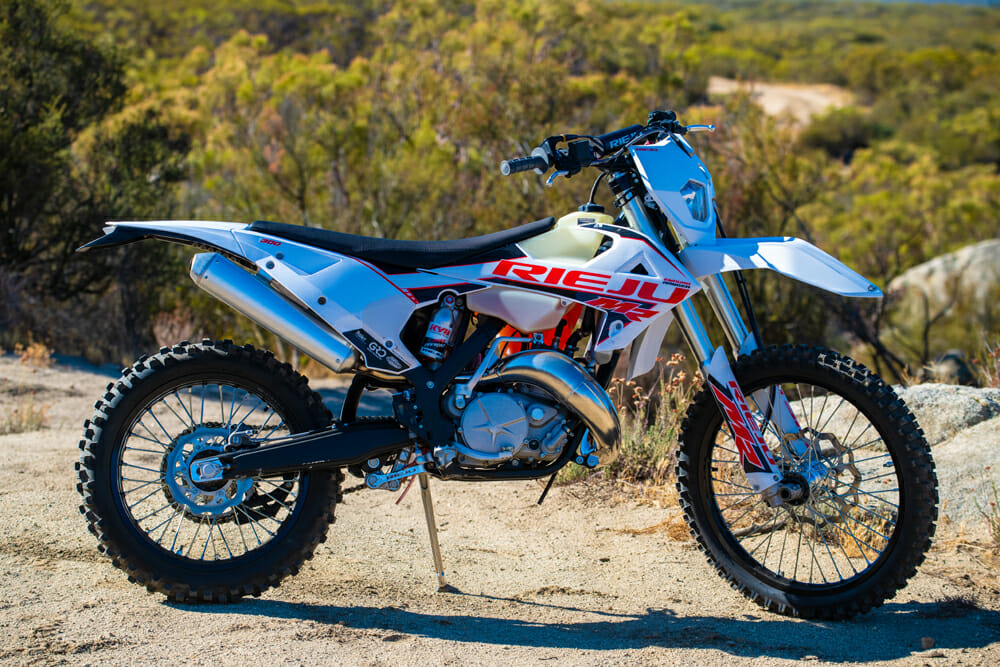

2022 Rieju MR Ranger 300 / 200 Specifications
| MSRP: | $8799/ $8599 |
| Engine: | 2-stroke, single cylinder |
| Displacement: | 299.3cc / 199.4cc |
| Bore x Stroke: | 72 x 72mm / 62.5 x 65mm |
| Starting System: | Electric & Kick |
| Ignition: | Electronic |
| Transmission: | 6-speed |
| Clutch: | Wet, multi-disc |
| Fueling System: | Carburetor, Keihin PWK 36mm |
| Intake: | Direct reed-valve, V-Force 4 |
| Muffler: | Technigas aluminum, repackable |
| Handlebar: | 11/8 in., tapered aluminum |
| Frame: | Chrome-molybdenum, central backbone, aluminum alloy subframe |
| Swingarm: | Aluminum |
| Front Suspension: | KYB, 46mm open cartridge |
| Rear Suspension: | KYB single shock, linkage adj. compression, rebound damping |
| Front-Wheel Travel: | 10.6 in. |
| Rear-Wheel Travel: | 10.6 in. |
| Front Wheel: | Aluminum rim, spoke, 1.6 x 21 in. |
| Rear Wheel: | Aluminum rim, spoke, 2.18 x 18 in. |
| Front Tire: | Vee Rubber 90/90-21 in. |
| Rear Tire: | Vee Rubber 120/90-18 in. |
| Front Brake: | Nissin caliper, 260mm disc |
| Rear Brake: | Nissin caliper, 220mm disc |
| Fuel Capacity: | 2.64 gal. |
| Dry Weight (claimed): | 241 lbs. |
| Wheelbase: | 58.3 in. |
| Seat Height: | 36.3 in. |
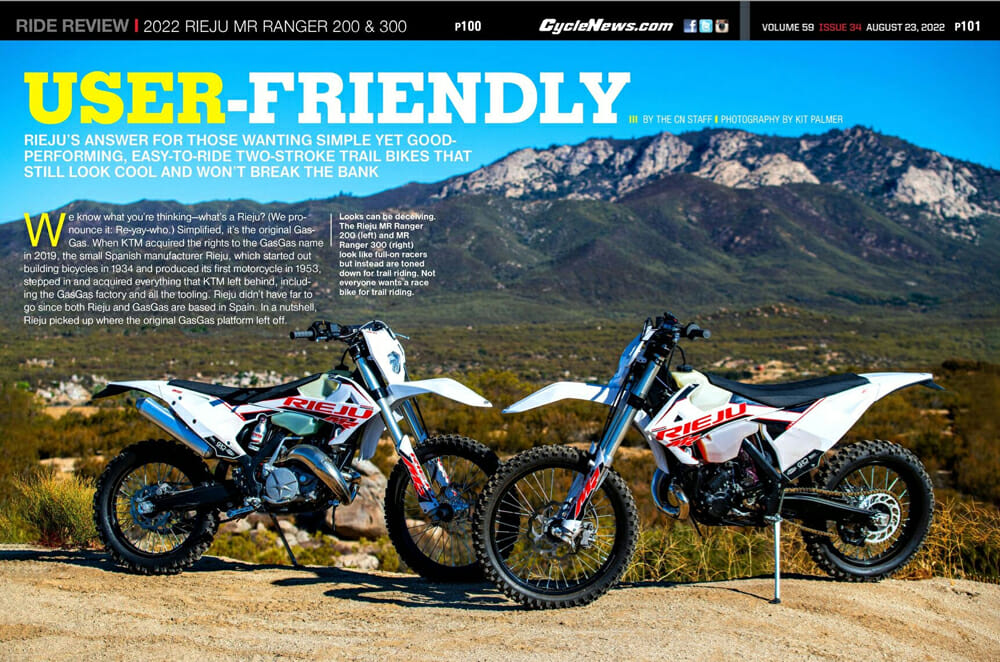
Click here to read the 2022 Rieju MR Ranger 200 & 300 Review in the Cycle News Digital Edition Magazine.
Click here for all the latest Off-Road Racing news.
Click here for more GasGas motorcycle reviews and news.
